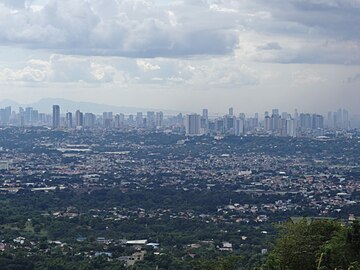List of metropolitan areas in the Philippines
| Cities and municipalities of the Philippines |
|---|
 |
|
The Philippines has three metropolitan areas officially recognized by the National Economic and Development Authority (NEDA) due to their prominence, population, size, and economy: Manila, Cebu, and Davao.[1][2] The most populous is Metro Manila, which comprises the City of Manila, 15 neighboring cities, and a municipality. The largest by land area is Metro Davao in Mindanao.
Previously, NEDA recognized ten other metropolitan areas: Metro Angeles, Metro Bacolod, Metro Baguio, Metro Batangas, Metro Cagayan de Oro, Metro Dagupan, Metro Iloilo–Guimaras, Metro Naga, and Metro Olongapo. However, these ten were not included as official metropolises in the 2017–2022 Philippine Development Plan created by NEDA.[3] By 2025, the population of Metro Cagayan de Oro is expected to reach a level that would allow it to be reclassified as a metropolitan area.[4]
The official definition of each metropolitan area, as listed below, does not necessarily follow the actual extent of continuous urbanization. For example, the built-up area of Metro Manila has long spilled out of its borders into the adjacent provinces of Bulacan, Cavite, Laguna, and Rizal.[5]
List
[edit]History
[edit]In 2020, 54% of the Philippine population lived in urban areas[11] encompassing many cities. Growth in some cities has led to urban spillover in adjacent municipalities.
Metro Manila was created in 1975 with the establishment of the Metro Manila Commission. This commission, reorganized in 1986 as the Metro Manila Authority, was renamed in 1995 as the Metropolitan Manila Development Authority (MMDA). While MMDA has no power over the local government units (LGUs) it covers, it has worked with the LGUs to solve issues that affect all of them such as traffic management.
The practice of creating an intercity board or agency to determine the limits of a metropolitan area has become common.[citation needed] A number of proposals have been created to create similar metropolitan arrangements in other areas of the country. In 1997, Cebu created the Metropolitan Cebu Development Council (MCDC), which was renamed the Metropolitan Cebu Development and Coordinating Board (MCDCB) in 2011. In 2022, Baguio[12] and Davao created their own metropolitan boards. Other proposed metropolitan boards include ones for Bulacan and Bataan.
List of built-up urban areas
[edit]The following table lists urban areas in the Philippines, with a population of over 500,000, according to Demographia's "World Urban Areas" study as of 2023. Demographia defines an urban area as a continuously built up land mass of urban development that is within a labor and housing market, without regard for administrative boundaries.[13]
| Rank | Urban Area | Est. Population | Built-up Area (sq miles) | Built-up Area (sq km) | Pop. Density (per sq miles) | Pop. Density (per sq km) |
|---|---|---|---|---|---|---|
| 1 | Manila | 24,156,000 | 738 | 1,911 | 32,732 | 12,638 |
| 2 | Cebu City | 2,482,000 | 79 | 205 | 31,418 | 12,130 |
| 3 | Davao City | 1,379,000 | 50 | 130 | 27,580 | 10,649 |
| 4 | Cagayan de Oro | 723,000 | 27 | 70 | 26,778 | 10,339 |
| 5 | Angeles City | 712,000 | 72 | 186 | 9,889 | 3,818 |
| 6 | Bacolod | 611,000 | 32 | 83 | 19,094 | 7,372 |
| 7 | Iloilo City | 542,000 | 35 | 91 | 15,486 | 5,979 |
| 8 | Zamboanga City | 539,000 | 21 | 54 | 25,667 | 9,910 |
| 9 | General Santos | 529,000 | 36 | 93 | 14,694 | 5,674 |
Gallery
[edit]-
Metro Manila
-
Metro Cebu
-
Metro Davao
See also
[edit]- List of cities in the Philippines
- List of metropolitan areas in Asia
- List of urban agglomerations in Asia
References
[edit]- ^ a b "Chapter 3: Overlay of Economic Growth, Demographic Trends, and Physical Characteristics" (PDF). Philippine Development Plan 2017-2022. National Economic and Development Authority: 37–38. 2017. Archived from the original (PDF) on July 25, 2020. Retrieved August 1, 2020.
- ^ "Overlay of Economic Growth, Demographic Trends, and Physical Characteristics" (PDF). National Economic Development Authority of the Philippines.
- ^ "Building Globally Competitive Metro Areas in the Philippines" (PDF). National Economic and Development Authority. August 30, 2007. Archived from the original (PDF) on October 4, 2013. Retrieved February 6, 2014.
- ^ Encarnacion, Ronnie; Magnaye, Dina; Castro, Annlouise Genevieve (January 4, 2023). "Spatial Analysis of Local Competitiveness: Relationship of Economic Dynamism of Cities and Municipalities in Major Regional Metropolitan Areas in the Philippines" (PDF). Sustainability. 15 (2): 4. doi:10.3390/su15020950 – via ResearchGate.
- ^ "Demographia World Urban Areas, 12th Annual Edition: 2016:04" (PDF). 2016. Archived from the original (PDF) on February 21, 2017. Retrieved March 24, 2017.
Higher than other estimates, which are largely limited to the National Capital Region. Continuous urbanization extends into Cavite, Laguna, Bulucan [sic] and Rizal.
- ^ Census of Population (2020). Table B - Population and Annual Growth Rates by Province, City, and Municipality - By Region. Philippine Statistics Authority. Retrieved 8 July 2021.
- ^ "Philippine Standard Geographic Code". PSGC Interactive. Quezon City, Philippines: Philippine Statistics Authority. Archived from the original on July 6, 2016. Retrieved September 9, 2016.
- ^ "Philippine Standard Geographic Code". PSGC Interactive. Quezon City, Philippines: Philippine Statistics Authority. Archived from the original on July 6, 2016. Retrieved September 9, 2016.
- ^ "What is MCDCB?". Mega Cebu Blog. March 2, 2014. Retrieved January 11, 2017.
- ^ Joviland Rita (April 27, 2022). "Duterte OKs creation of Metropolitan Davao Development Authority". GMA News Online. Retrieved 27 April 2022.
- ^ "Urban Population of the Philippines (2020 Census of Population and Housing)". Philippine Statistics Authority. 5 July 2022. Retrieved 7 May 2023.
- ^ Keith, Gaby B. "Metro Baguio Devt Authority now a law". The Manila Times. Manila Times Publishing Corp. Retrieved May 28, 2023.
- ^ Cox, Wendell (August 2023). "World Urban Areas 19th Annual: 2023" (PDF). Demographia. Retrieved 1 October 2024.



